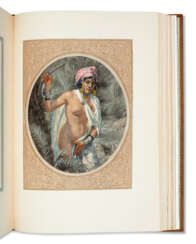насреддин дине (1861 - 1929)

Nasreddine Dinet, originally known as Alphonse-Étienne Dinet, was a French Orientalist painter, renowned for his depictions of North African culture. He won a silver medal for painting at the Exposition Universelle in 1889 and founded the Société Nationale des Beaux-Arts along with notable artists like Meissonier and Rodin. Dinet's enchantment with North Africa led him to convert to Islam and change his name, reflecting his deep engagement with Arab culture and language, which set him apart from his contemporaries. His works, characterized as conservative and ethnographic, capture the nuances of local culture, from genre scenes to religious subjects. A prolific artist, Dinet also translated Arabic literature into French, contributing to cultural exchange.
His works are held in high regard, with examples like "The Snake Charmer" showing his technical prowess and cultural immersion. This painting and others are exhibited in prominent institutions such as the Art Gallery of New South Wales and the Musée d'Orsay. Dinet's understanding of Arab culture allowed him to portray women in spontaneous and dynamic ways, often employing a vivid color palette reminiscent of Fauvism. His legacy is preserved in the Nasreddine-Dinet Museum in Bou-Saâda and nearly 270 of his drawings are housed in the Louvre's Department of Graphic Arts.
Art collectors and experts recognize the significance of Dinet's work in bridging cultures through art. His contribution to Orientalist art provides a window into the traditions and stories of North African societies. For those interested in Dinet's work, private collections and auctions offer opportunities to acquire his art, with sales history indicating active interest in pieces like "Femmes arabes au cimetière."
For updates on new product sales and auction events related to Nasreddine Dinet, sign up for our newsletter. Stay informed on the latest opportunities to acquire works by this esteemed artist without superfluous flair, just the essential information for collectors and connoisseurs.


Nasreddine Dinet, originally known as Alphonse-Étienne Dinet, was a French Orientalist painter, renowned for his depictions of North African culture. He won a silver medal for painting at the Exposition Universelle in 1889 and founded the Société Nationale des Beaux-Arts along with notable artists like Meissonier and Rodin. Dinet's enchantment with North Africa led him to convert to Islam and change his name, reflecting his deep engagement with Arab culture and language, which set him apart from his contemporaries. His works, characterized as conservative and ethnographic, capture the nuances of local culture, from genre scenes to religious subjects. A prolific artist, Dinet also translated Arabic literature into French, contributing to cultural exchange.
His works are held in high regard, with examples like "The Snake Charmer" showing his technical prowess and cultural immersion. This painting and others are exhibited in prominent institutions such as the Art Gallery of New South Wales and the Musée d'Orsay. Dinet's understanding of Arab culture allowed him to portray women in spontaneous and dynamic ways, often employing a vivid color palette reminiscent of Fauvism. His legacy is preserved in the Nasreddine-Dinet Museum in Bou-Saâda and nearly 270 of his drawings are housed in the Louvre's Department of Graphic Arts.
Art collectors and experts recognize the significance of Dinet's work in bridging cultures through art. His contribution to Orientalist art provides a window into the traditions and stories of North African societies. For those interested in Dinet's work, private collections and auctions offer opportunities to acquire his art, with sales history indicating active interest in pieces like "Femmes arabes au cimetière."
For updates on new product sales and auction events related to Nasreddine Dinet, sign up for our newsletter. Stay informed on the latest opportunities to acquire works by this esteemed artist without superfluous flair, just the essential information for collectors and connoisseurs.


Nasreddine Dinet, originally known as Alphonse-Étienne Dinet, was a French Orientalist painter, renowned for his depictions of North African culture. He won a silver medal for painting at the Exposition Universelle in 1889 and founded the Société Nationale des Beaux-Arts along with notable artists like Meissonier and Rodin. Dinet's enchantment with North Africa led him to convert to Islam and change his name, reflecting his deep engagement with Arab culture and language, which set him apart from his contemporaries. His works, characterized as conservative and ethnographic, capture the nuances of local culture, from genre scenes to religious subjects. A prolific artist, Dinet also translated Arabic literature into French, contributing to cultural exchange.
His works are held in high regard, with examples like "The Snake Charmer" showing his technical prowess and cultural immersion. This painting and others are exhibited in prominent institutions such as the Art Gallery of New South Wales and the Musée d'Orsay. Dinet's understanding of Arab culture allowed him to portray women in spontaneous and dynamic ways, often employing a vivid color palette reminiscent of Fauvism. His legacy is preserved in the Nasreddine-Dinet Museum in Bou-Saâda and nearly 270 of his drawings are housed in the Louvre's Department of Graphic Arts.
Art collectors and experts recognize the significance of Dinet's work in bridging cultures through art. His contribution to Orientalist art provides a window into the traditions and stories of North African societies. For those interested in Dinet's work, private collections and auctions offer opportunities to acquire his art, with sales history indicating active interest in pieces like "Femmes arabes au cimetière."
For updates on new product sales and auction events related to Nasreddine Dinet, sign up for our newsletter. Stay informed on the latest opportunities to acquire works by this esteemed artist without superfluous flair, just the essential information for collectors and connoisseurs.






